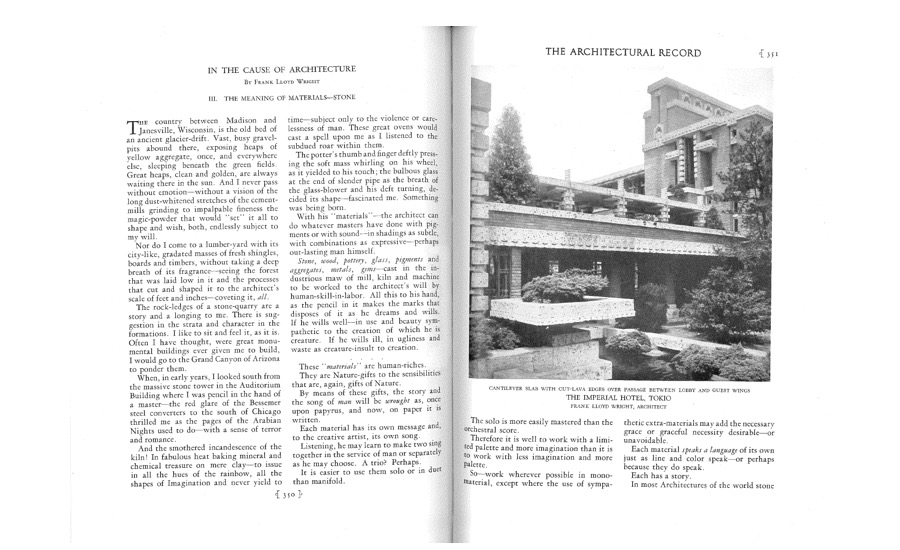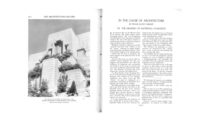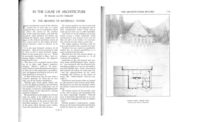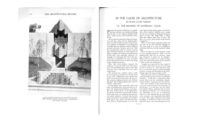A greater triumph will be man’s when he triumphs through the nature of matter over the superstition that separates him from its spirit.
And that is where he is now in his industrial world as he faces stone, as an architect. As he sees stone in the story recorded by the buildings on the earth – there is not so much to help him now.
To “imitate” would be easy but no man’s way.
His present tool the Machine can clumsily imitate, but without joy or creative impulse behind it when imitation is its menial office. As a mass-material he can now handle stone better and cheaper than ever before, if he allows it to be itself- if he lets it alone for what it is.
Or if – sympathetically – he brings out its nature in his use of it. The Chinese did this in the way they cherished and developed the natural beauties of jade – lapis-lazuli – crystal – malachite and cornelian, quartz – and great-stones as well.
Man has done this with his machine when he has sawed the blocks of marble and, opening them into thin slabs, spread them, edge to edge, upon walls as facings revealing and accenting its own pattern and color.
He has done this when he planes it and lays it up in a straight-line mass for its own sake, with the texture characteristic of his tools.
He has done this when he takes the strata of the quarry and lays it in like strata, natural edges out – in his walls. He has done this when he makes mosaic of stones and lays them in simple stone-patterns in color, for whole buildings – stone brocade.
He does this, when, inspired by the hardness and brilliance of the granite his Machine can now render so well, he makes his ultimate form as simple and clearly hard in mass and noble in outline when finished.
He may even introduce alternate and contrasting materials qualifying broad masses harmonious with stone qualities in horizontal bands or rich masses. Whenever, in his designs, he allows the natural beauty of the stone, as stone, to speak its own material-language, he has justified his machine as an artist’s tool. And the nobility of his work will compensate for the loss of the imitations of organic-forms-of-life in the material itself – an imitation that used to be architecture.
Interpretation is still his.
So it will be seen again, as always, that if he now works with stone in this sense, using the new power which the machine has given him over it, he will gain a spiritual integrity and physical health to compensate him for the losses of the storyful beauties of that period, since passed, when a building, so far as its architecture was concerned, was a clock of ornamentally sculptured stone.
It would take a volume to fully illustrate the story that is here written – a mere sketch in bare outline.
In each of the materials we have named out there is treasure enough to make Aladdin’s cave a mean symbol of an architect’s riches, were each architect confined to only one.
Aladdin’s lame was a symbol for Imagination.
With this lamp the architect may explore the riches of the deep caves where treasure is waiting for him. And, through him, the human race waits too; for the key that unlocks the man-made door is hanging at his belt – still – though rusty with disuse and the lock itself now stiff with rust and lack of proper oiling.
Let him take his microscope and see the principle that “builds”, in nature, at work in stone. Geometry the principle, busy with materials – producing marvels of beauty to inspire him. Read the grammar of the Earth in a particle of stone! Stone is the frame on which his Earth is modeled, and wherever it crops out – there the architect may sit and learn.
As he takes the trail across the great Western Deserts – he may see his buildings – rising in simplicity and majesty from their floors of gleaming sand – where organic life is still struggling for a bare existence: see them still, as the Egyptians saw and were taught by those they knew.
For in the stony bone-work of the Earth, the principles that shaped stone as it lies, or as it rises and remains to be sculptured by winds and tide – there sleep forms and styles enough for all the ages for all of Man.
NOTE: - See issue of Wendingen, Number 11 in 6th Series of 1914. Architect Widjeveldt Vossuistraat – Amsterdam – for a marvelous exposition of geometry at work in materials – Called the Architectonishe Phantasieen in de Wereld Der Kristallen.







